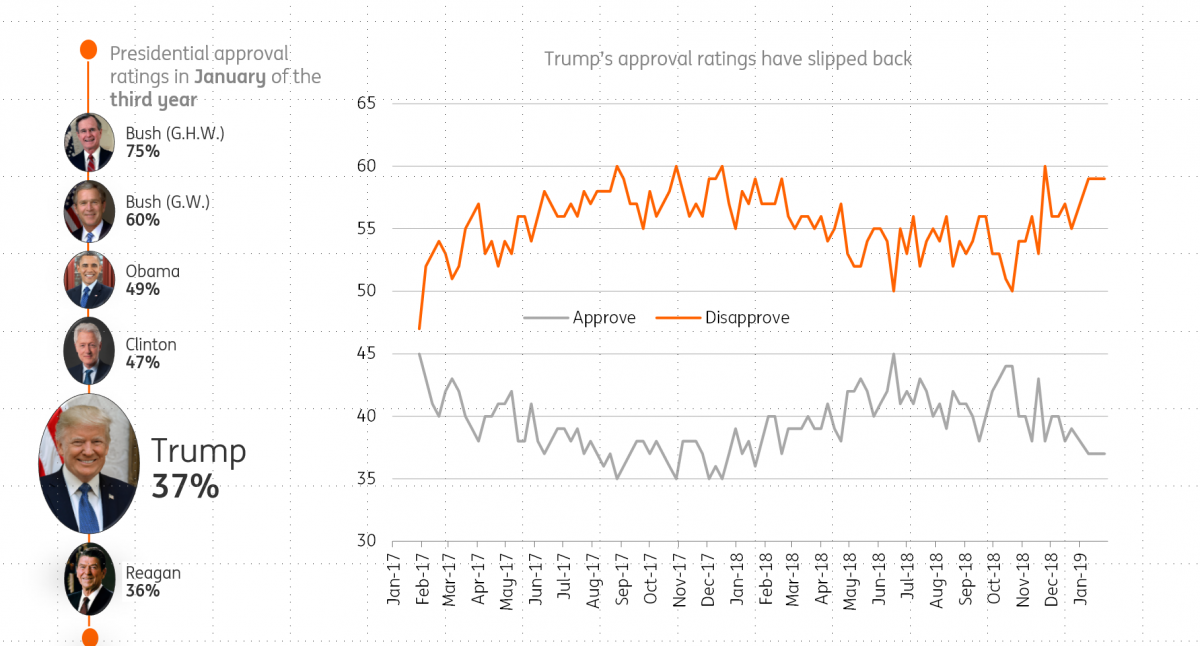US State of the Union: Building walls, not bridges
The President’s State of the Union address spoke about bi-partisanship, but the government shutdown and a lack of policy thrust highlight the problems he faces with a divided government
A hint of an olive branch...
President Trump’s 82 minute speech to Congress spoke of a need for the Republicans and Democrats to come together for the good of the American people. He talked of efforts to reduce drug prices and repeated his calls for bi-partisan cooperation on infrastructure investment, although there was next to no detail on what that may involve. The President also repeated calls for support for the border security wall with Mexico, but stopped short of saying he would declare a national emergency and get it built himself should that support not come. Obviously the potential for such action remains firmly on the table.
He was even more vague on US-China trade policy, merely stating that “I have great respect for President Xi, and we are now working on a new trade deal with China. But it must include real, structural change to end unfair trade practices, reduce our chronic trade deficit, and protect American jobs.”
However, in a warning shot to Europe and their car exports to America, he made the plea to Congress, “I am also asking you to pass the United States Reciprocal Trade Act, so that if another country places an unfair tariff on an American product, we can charge them the exact same tariff on the exact same product that they sell to us.” Europe charges a 10% tariff on American made cars while America charges only a 2.5% tariff on EU made car imports. On this front, we are focused on the US Commerce Department’s report (due 17 February) on whether the import of cars is a threat to US national security, which could trigger a stepping up of US-EU tensions.
Popularity isn't everything...

It could be worse
Given tensions in Washington, the Democrats were always going to be blasted somewhere along the line. President Trump criticised them for the way they have acted since winning control of the House by stating “we must reject the politics of revenge, resistance and retribution”. But this is the world we live in and buoyed by their perceived “victory” in the government shutdown debacle the Democrat policy of “resistance” is set to continue.
Given this backdrop we are worried about the potential for another government shutdown – though not necessarily after the deadline of getting Democrat support for funding the border security wall in mid-February as Trump can indeed declare a national emergency and fund it himself. Potentially more significantly, 1 March sees the reintroduction of the government debt ceiling and given the national debt is already above this level, there could be a major battle here.
Trump so far is getting most of the blame for the discord on Capitol Hill as can be seen in his slumping approval ratings with less than two years to go before the 2020 Presidential election. But it is important to remember that all is not lost. Looking at the "modern" comparisons, only Ronald Reagan was in a weaker position at this stage in his Presidency, yet he won 58.8% of the popular vote at the 1984 election, carrying 49 of the states. Conversely, George HW Bush had an approval rating of 75%, yet lost the election the following year. A strong economy, a deal with North Korea and the potential for an attritional and contentious set of Democrat primaries ahead of that 2020 election make these current polls pretty meaningless.
Download
Download article
5 February 2019
In case you missed it: Trade truce withering away This bundle contains 8 ArticlesThis publication has been prepared by ING solely for information purposes irrespective of a particular user's means, financial situation or investment objectives. The information does not constitute investment recommendation, and nor is it investment, legal or tax advice or an offer or solicitation to purchase or sell any financial instrument. Read more
